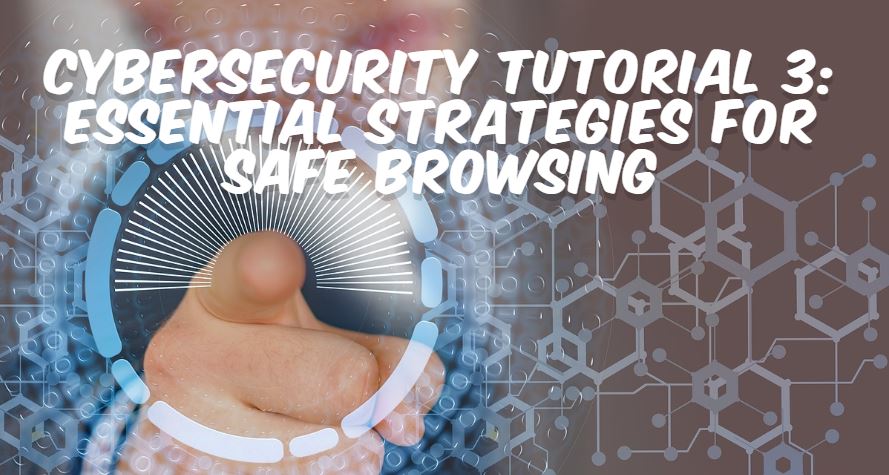
Welcome back to our Cybersecurity Tutorial series on lookkle.com! In this third installment, we'll dive deep into the essential strategies for safe browsing, a crucial aspect of cybersecurity that affects everyone who uses the internet. As we navigate the digital landscape, it's vital to understand how to protect ourselves from the myriad of threats lurking online. Let's explore the fundamental principles and practical tips that will help you browse the web safely and securely.
Understanding the Importance of Safe Browsing
In today's interconnected world, the internet has become an integral part of our daily lives. We use it for work, entertainment, shopping, and communication. However, this increased reliance on the web also exposes us to various cyber threats. Malicious actors are constantly developing new ways to exploit vulnerabilities and compromise our personal information. Safe browsing practices are our first line of defense against these threats.
The Foundations of Cybersecurity
Before we delve into specific strategies, let's revisit the core principles of cybersecurity:
- Confidentiality: Ensuring that sensitive information is accessible only to authorized individuals.
- Integrity: Maintaining the accuracy and consistency of data throughout its lifecycle.
- Availability: Guaranteeing that authorized users have access to information and resources when needed.
These principles, known as the CIA triad, form the foundation of all cybersecurity efforts, including safe browsing practices.
Essential Strategies for Safe Browsing
1. Keep Your Browser Up-to-Date
One of the simplest yet most effective ways to enhance your browsing security is to keep your web browser updated. Browser developers regularly release updates that patch security vulnerabilities and improve overall performance. Enable automatic updates to ensure you're always using the latest, most secure version of your browser.
2. Use Strong, Unique Passwords
While this may seem basic, the importance of strong passwords cannot be overstated. Create complex passwords using a mix of uppercase and lowercase letters, numbers, and special characters. Avoid using the same password across multiple sites. Consider using a password manager to generate and store strong, unique passwords for all your accounts.
3. Enable Multi-Factor Authentication (MFA)
MFA adds an extra layer of security by requiring users to provide two or more verification factors to gain access to an account. This could be something you know (password), something you have (a smartphone), or something you are (biometric data). Whenever possible, enable MFA on your accounts to significantly reduce the risk of unauthorized access.
4. Be Wary of Phishing Attempts
Phishing remains one of the most common and effective cyber attacks. Be cautious of unsolicited emails, messages, or pop-ups asking for personal information. Legitimate organizations will never ask for sensitive data via email. When in doubt, contact the company directly using their official website or phone number.
5. Use HTTPS Connections
Always check that the websites you visit use HTTPS (Hypertext Transfer Protocol Secure) instead of HTTP. HTTPS encrypts the data transmitted between your browser and the website, making it much harder for attackers to intercept and steal your information. Look for the padlock icon in your browser's address bar to confirm a secure connection.
6. Implement a Virtual Private Network (VPN)
A VPN creates a secure, encrypted tunnel for your internet traffic, making it difficult for hackers to intercept your data. This is especially important when using public Wi-Fi networks, which are often unsecured and vulnerable to attacks. Choose a reputable VPN service and use it consistently, especially when accessing sensitive information online.
7. Be Cautious with Downloads
Exercise caution when downloading files from the internet. Only download from trusted sources and be wary of executable files (.exe) as they can potentially contain malware. Use antivirus software to scan downloaded files before opening them.
8. Manage Your Browser Extensions
While browser extensions can enhance functionality, they can also pose security risks. Only install extensions from trusted sources and regularly review your installed extensions, removing any that you no longer use or trust.
9. Use Private Browsing Mode
When using shared or public computers, always use your browser's private or incognito mode. This prevents your browsing history, search records, and cookies from being saved on the device. However, remember that private browsing doesn't make you completely anonymous online.
10. Educate Yourself on Social Engineering Tactics
Cybercriminals often use social engineering techniques to manipulate users into divulging sensitive information. Learn to recognize common tactics such as urgency, authority, and scarcity in messages that attempt to solicit personal data or prompt hasty actions.
Advanced Safe Browsing Techniques
As we delve deeper into cybersecurity, consider implementing these advanced techniques:
1. Sandbox Browsing
Use a sandbox environment for browsing potentially risky websites. A sandbox isolates the browsing session from your main system, preventing any malware from affecting your computer.
2. DNS-over-HTTPS (DoH)
Enable DNS-over-HTTPS in your browser settings. This encrypts your DNS queries, making it harder for attackers to eavesdrop on or manipulate your browsing activity.
3. Content Blockers
Implement content blockers to prevent malicious scripts and unwanted advertisements from loading. This not only enhances security but also improves browsing speed and privacy.
4. Hardware Security Keys
For critical accounts, consider using hardware security keys as an additional authentication factor. These physical devices provide robust protection against phishing and account takeovers.
5. Browser Compartmentalization
Use different browsers for different activities. For example, use one browser for general browsing and another for sensitive tasks like online banking. This limits the potential impact of a security breach.
Staying Informed and Adapting to New Threats
The cybersecurity landscape is constantly evolving, with new threats emerging regularly.
Stay informed about the latest security trends and threats by:
- Following reputable cybersecurity news sources and blogs.
- Participating in online cybersecurity forums and communities.
- Attending webinars or workshops on internet security.
- Regularly reviewing and updating your security practices.
Creating a Culture of Cybersecurity
Safe browsing isn't just an individual responsibility; it's a collective effort. Whether at home or in the workplace, promote a culture of cybersecurity by:
- Sharing knowledge and best practices with friends, family, and colleagues.
- Encouraging open communication about potential security risks or incidents.
- Leading by example in implementing strong security measures.
- Supporting and participating in cybersecurity awareness initiatives.
The Role of Antivirus and Security Software
While safe browsing practices are crucial, they should be complemented by robust antivirus and security software. These tools provide an additional layer of protection by:
- Detecting and removing malware.
- Providing real-time protection against emerging threats.
- Offering secure browsing features and phishing protection.
- Regularly updating their threat databases to stay ahead of new malware strains.
Choose a reputable antivirus solution and ensure it's always up-to-date. However, remember that no software can provide 100% protection, which is why safe browsing habits remain essential.
Handling Sensitive Information Online
When dealing with sensitive information such as financial data or personal identifiers, take extra precautions:
- Avoid accessing sensitive accounts on public Wi-Fi networks.
- Use encrypted communication channels when sharing sensitive data.
- Regularly monitor your accounts for any suspicious activity.
- Consider using dedicated devices for sensitive transactions.
The Importance of Regular Security Audits
Periodically conduct a security audit of your browsing habits and digital footprint:
- Review your online accounts and close any that you no longer use.
- Check the privacy settings on your social media accounts.
- Audit the permissions granted to apps and browser extensions.
- Review your saved passwords and update any that are weak or outdated.
Preparing for the Worst: Incident Response
Despite our best efforts, security incidents can still occur. Having an incident response plan can help minimize damage:
- Know how to quickly change passwords across your accounts.
- Understand the steps to report identity theft or unauthorized access.
- Keep backups of important data to aid in recovery.
- Have a list of emergency contacts, including your bank and local authorities.
The Future of Safe Browsing
As technology evolves, so too will the methods we use to stay safe online. Keep an eye on emerging technologies and practices:
- Artificial Intelligence in threat detection and prevention.
- Blockchain for secure online transactions and identity verification.
- Quantum cryptography for unbreakable encryption.
- Biometric authentication becoming more prevalent in everyday browsing.
Conclusion
Safe browsing is a critical component of overall cybersecurity. By implementing the strategies and techniques discussed in this tutorial, you can significantly reduce your risk of falling victim to cyber threats.
Remember, cybersecurity is an ongoing process that requires vigilance, education, and adaptation.
Tips on SEO and Online Business
Next Articles
Previous Articles






